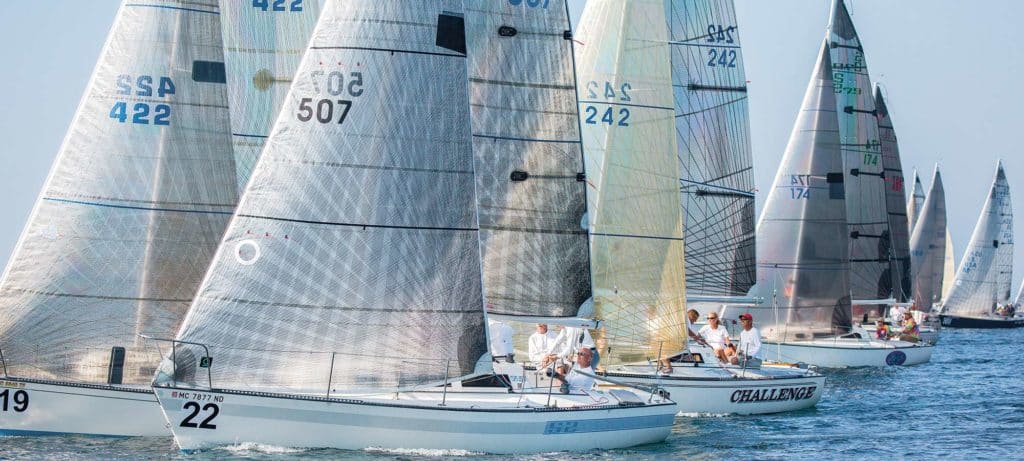
It’s late Sunday morning, and I’m aboard Chris Craig’s S2 7.9 for the National Championship. The mainsail slats as we wait for wind. A few sailors swim, and one practices backflips off his boat’s bow pulpit while the race committee dispatches its mark-set boats in multiple directions to scout for breeze elsewhere on Lake Michigan. We soon hear their reports over the VHF radio: There’s not much out there.
We’re wallowing in the middle of a large and stubborn high-pressure system. It’s hot, and hardly September weather for Holland, Michigan, but we’re optimistic. This time of the year is usually a sure bet for wind, which is part of the reason the S2 7.9 class scheduled its 2017 championship here. Plus, our host, Macatawa YC, provides a great home base and easy access to the broad lake, making it even more appealing. It’s been “that kind of summer” — one plagued with light winds. Still, everyone is taking the drifting in stride. Maybe that’s because S2 7.9 racers are a patient lot.
Or maybe because they’re just happy to be together again, assembled in this special place where the whole S2 thing started more than 30 years ago.
Eight miles down 32nd Street from Macatawa YC is the sprawling Tiara Yachts boatbuilding plant. Today they build 30- to 53-foot luxury motor yachts, but from 1980 and 1994, the building was occupied by S2 Yachts, which put out an eclectic line of sailboats that included the 7.9. Riding the 20-footer movement of the late 1970s, which was sparked by the J/24 and eventually included boats like the Merit 25 and Olson 25, the 7.9 hit a sweet spot with recreational racers. Its lifting daggerboard allows it to be ramp launched and floated in 18 inches of water, and its deck-stepped mast can be raised by two people, making it a perfectly trailerable raceboat. The 7.9s were also built to last and retain a good resale value to this day. Plus, there’s an interior that packs in a lot for a 26-footer — three berths, a galley and a head.
While other designs of the time struggled to catch on, the 7.9 was a comparative overnight success. One-design racing fleets sprang up throughout Michigan and as far south as Nashville, Tennessee, and Florida. The 7.9, dubbed a “giant killer,” also excelled in PHRF and Midget Ocean Racing Club regattas. When production ended, 545s were built.
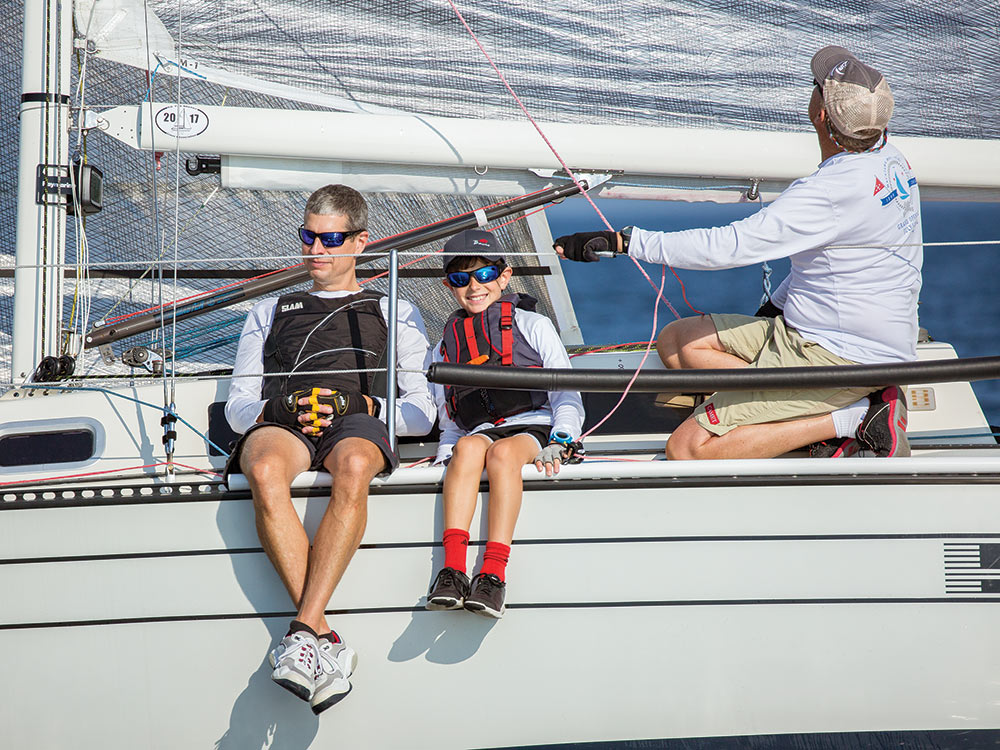
The Slikkers family founded the S2 company, hence the “S” in the name. Its sailboat line represented the company’s restart after selling its successful powerboat line to AMF. Designed by the late Scott Graham and Eric Schlageter, from Chicago, the first 7.9s were sold as the Grand Slam line, and although the name clearly represented what they hoped it would be, the boat was soon rebranded 7.9, which is the boat’s length in meters — that’s 25 feet 11 inches for imperialists.
It’s a testament to Graham and Schlageter’s utilitarian design that the boats remain sought after three decades later. “The value has stayed in the boats because they’re well-built and because of the price point,” says Tim Bosma, who has crewed aboard the 7.9 Hot Tamale since 1994.
Bosma also maintains the class’s one forum and some of its databases, so he has a good handle on what’s out there on the open market. “A while back, my skipper and I picked up one in Traverse City, Michigan, with a trailer, for around $7,000,” he confesses. “We’ll fix it up and sell it.”
The boat is a “blue-collar boat,” says Craig, who has been sailing 7.9s since he was 10.
Few people spend a lot of money on their boats, and class rules allow up to only two new sails a year. “Show up with bottom paint and race against boats with polished, clean fiberglass bottoms and still do well,” Craig says. “Boat age isn’t a delineating factor.” For example, the oldest boat at the championship is hull No. 7, owned by Drew Hilger, of Bay City, Michigan. No. 7 was built in 1981, and Hilger changed his sail number to 007 and named the boat Bond Girl, which is a reference to his wife’s employment at Gougeon Brothers Inc., manufacturers of West System epoxy.
“We’ve had it for three years,” Hilger says. “I don’t think it had seen much use, but it was also never upgraded. None of the blocks were ball-bearing, the cam cleats were not too friendly, and it had a lot of wire.”
The unspoken rule in 7.9 sailing is “the more the merrier.” To a point, of course, because the cockpit can accommodate only so many elbows.
Like many other 7.9 owners, the Hilgers bought one because they wanted a boat to race and cruise. “It just checked all the boxes. We took ours to Leeland [Michigan], sailed out to south Manitou Island, and spent three nights there,” he says. “With a 30-footer, it’s a three-day cruise to get there. We just put it on the trailer and were on the island later that day.”
This year’s championship is Hilgers’ first one-design event with the class, and they eventually learn that all S2 7.9s seem to move at about the same rate of speed, which means that once positions settle down in a race, there’s not much passing to be had, give or take a few nearby boats. And, it doesn’t seem to matter how many crew one has onboard. The unspoken rule in 7.9 sailing is “the more the merrier.” To a point, of course, because the cockpit can accommodate only so many elbows.
“Crew weight is not a big deal in this class,” says Macatawa sailor Michael Kiss, “which means you can sail with anyone you want: Bring family, guests aboard — it all works.”
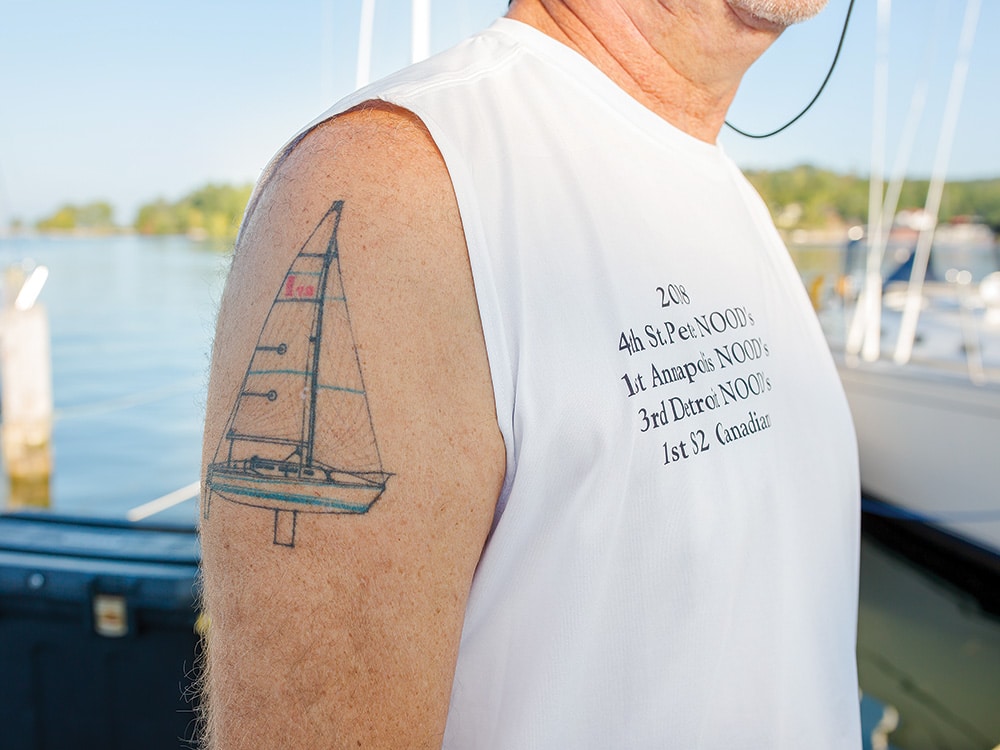
For the Holland championship, Kiss is sailing with his wife Tovi, son Mitchell, brother Stephen, nephew David and family friend Michael Norris. They finish fourth in the 28-boat fleet, winning the family trophy for the top boat sailing with three or more family members.
Meanwhile, aboard Second Wind, Don and Jean Bergman are sailing with their two sons. Don and Jean are veterans of the Sunfish class, with Don boasting of 30 Sunfish world-championship appearances to date. A few years after Don’s previous wife passed away, he married Jean, and began looking for a boat they could sail together. They’ve owned Second Wind for 28 years, which isn’t a rare accolade in this class, but their ages — Don is 86 and Jean is 78 — are noteworthy, especially after they win one of Saturday’s races. “It was so much fun,” says Don, “and the crew loved it. We got into the lead early and just protected it all the way around.”
Before heading into Saturday’s final races, Bergman was thinking it was the last regatta for his team, but after winning a race, he’s now motivated for more. “We’ll definitely do Detroit (site of the 2018 championship) next year,” he confesses, “and maybe a year or two after that.”
Coming from singlehanded-sailing backgrounds, the Bergmans both like to steer, which creates an unorthodox system on board Second Wind. “We started with him steering, but the problem is he wants to look around and see everything on the course,” says Jean. “I don’t have to do that. I can focus on just sailing.”
They agreed that Jean would drive upwind and Don would take the helm on the downwind legs. “It’s not the greatest idea, but it works for us,” says Jean, who sits behind Don as he gets the boat in position for the start.
“If I can get us in the right place,” he says, “I hand the tiller over to her with about five seconds to go, and she takes it from there.”
Like the Hilgers, the Bergmans travel extensively with their boat in tow, but with Holland, Michigan, as their home port, going to other regattas, such as Chicago, 85 miles away, or Racine, Wisconsin, 75 miles away, usually means sailing or motoring. For them, the boat is capable of handling just about anything.
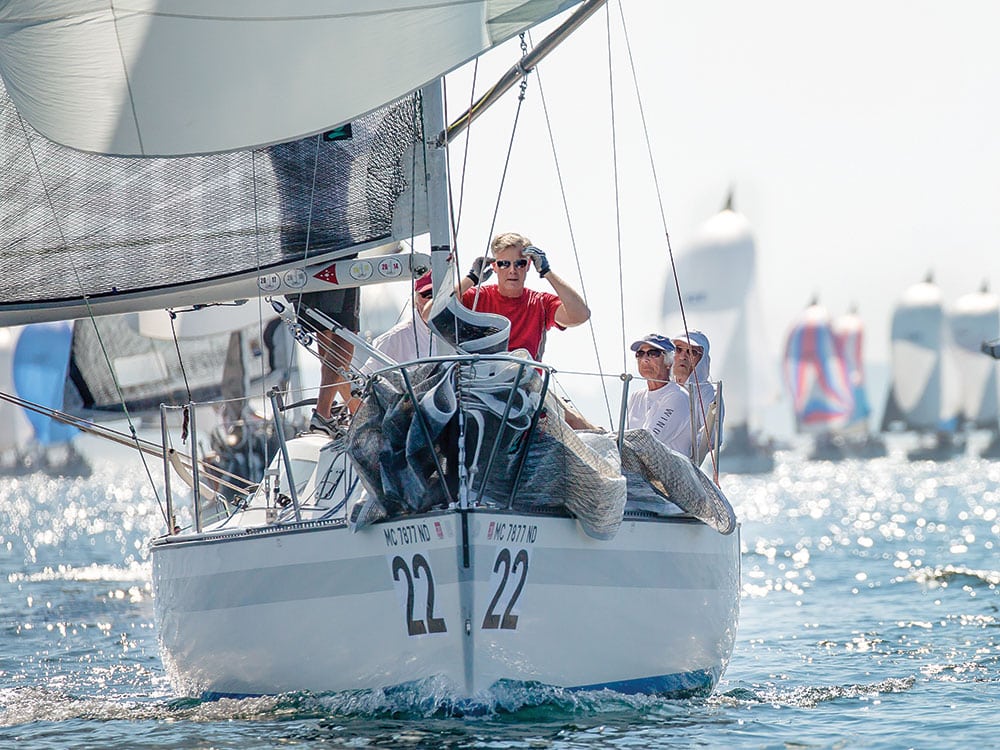
“One time, Jean and I were coming back at night, our motor quit, and our lights went out,” says Bergman. “The radio was telling everyone to get off Lake Michigan because a killer storm was coming, but we were right in the middle of the lake. So, we took the main down and sailed with our small jib. Jean was steering while I spilled the jib every time a 40-knotter hit. We couldn’t even see our compass. We just kept going.”
It’s a testament to Graham and Schlageter’s utilitarian design that the boats remain sought after three decades later.
Paul Letour, of Nashville, was 40 years old before he got his first sailboat. “I fell in love with the sport and went through a couple of boats,” he says. He didn’t understand one-design racing but grew into it and figured it out. “There were a couple of 7.9s where I live, so I joined up with them and never looked back.”
Letour then made the bold decision to attend a national championship. “We felt we were pretty good sailors, so we thought we’d see what we could do,” he says. “It was on Lake Erie, and out of 30 boats, we came in 30th. We went back with our tails between our legs, but I’m stubborn enough that I said, ‘Guys, we’ve got to do better.’ So, we kept going back and getting a little better each time. I wouldn’t go away.”
A retired dermatologist, one of Letour’s boats is named Itch and the other Scratch, but it’s more than just an homage to his former profession. “Itch is a synonym for a passion,” he says, “and a scratch boat is the boat you’ve got to beat, something you’ve just got to go after.”
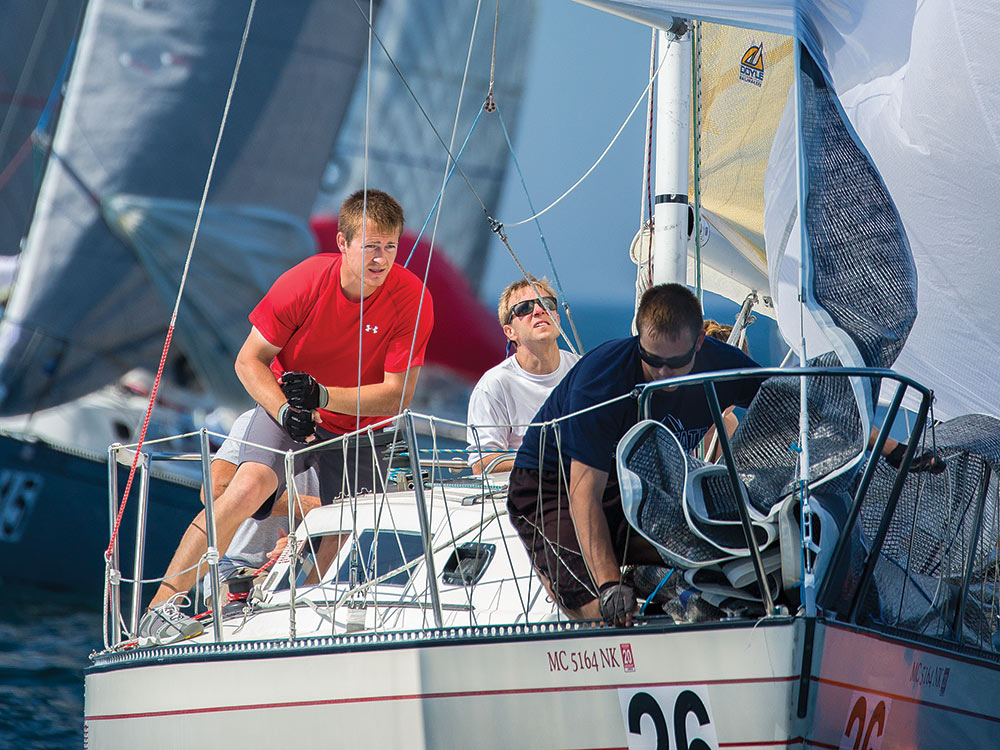
He especially likes the ability to easily transport the 7.9: “Put it on the trailer. Come to Nashville. Go to Racine. Go to Holland. It’s all so doable.”
Accessibility also ranks high on his list of the 7.9’s best attributes. “This is a boat that, with attention to detail, you can sail to its numbers in maybe two years,” he says. “I have friends in Nashville who sail other boats, and it will take them 15 years before they can race them like we do ours.”
At age 72, Letour maintains two 7.9s. He keeps one at each of the two yacht clubs in the Nashville area, which naturally makes him the local spark plug and salesman. Letour eventually convinced other owners to travel to Nashville for an annual event called the Equalizer, which is held on J. Percy Priest Lake. It’s become a regular part of the 7.9 circuit, in large part due to Letour’s Southern hospitality, which includes housing competitors and serving them his famous gumbo.
While there’s plenty of enthusiasm among 7.9 owners today, like any boat that’s no longer in production, the boat does present its challenges: It’s balsa-cored, which, according to Bosma, is rarely a problem in the hulls. “Once in a while you’ll find some wet spots in the deck,” he says.
Then there’s the issue of replacement parts. The class recently found a company to build a dozen masts to class specs. Next is sourcing a builder for replacement rudders, a topic the fleet tackles at the annual meeting one evening after racing.
“It’s just another issue, like the other ones,” says Letour, “and like those, we’ll get it figured out.”
Which is to say it’s like waiting for wind to complete a class championship on a warm Michigan day. Even if the breeze never materializes, they find a way to enjoy it. The company couldn’t be better.









